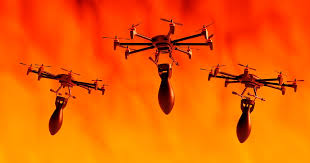On the night of May 8, red flares lit up the sky over Jammu. India’s air-defence systems were firing at unmanned aerial vehicles (UAVs) coming from Pakistan. It was the beginning of a new chapter in drone warfare between the two nuclear-armed rivals.
For decades, India and Pakistan have fought using fighter jets, missiles, and artillery. But the May clashes marked the first time both countries used drones on a large scale against each other. According to Reuters, this new phase in conflict is reshaping military tactics across South Asia.
The hostilities came to a halt after the United States brokered a ceasefire. However, both nations are now racing to enhance their drone warfare capabilities. Security officials, analysts, and executives from both sides confirmed the trend in interviews.
Two sources said that UAVs offer a unique advantage. They can strike targets without risking lives or triggering uncontrollable escalation. Small-scale drone attacks are becoming a preferred method of pressure.
India plans to triple its investment in drones. The country may spend around $470 million on UAVs in the next 12 to 24 months. This is a steep jump from pre-conflict spending. Smit Shah of Drone Federation India, representing over 550 drone companies, shared this estimate.
Earlier this month, India approved $4.6 billion for emergency military purchases. Part of this budget will go toward combat and surveillance drones. Two Indian officials confirmed this. According to Vishal Saxena from ideaForge Technology, drone makers are now being called for trials at record speed.
Pakistan is also expanding its drone warfare strategy. A Pakistani source revealed that the Air Force wants more UAVs to avoid risking expensive jets. During the May clashes, Pakistan used 4.5-generation J-10 fighters from China. India, in contrast, deployed over 36 Rafale jets.
Islamabad is strengthening its partnerships with Turkey and China. Oishee Majumdar of Janes said Pakistan is working with both countries to boost domestic drone development. Locally assembled YIHA-III drones from Turkish firm Baykar are being produced within two to three days.
Pakistan’s military declined to answer questions. India’s defence ministry and Baykar did not respond either.
According to political scientist Walter Ladwig III of King’s College London, drone warfare allows both nations to demonstrate strength without risking pilots or expensive jets. He noted that UAVs can hit populated or disputed areas where manned missions would be too risky.
The May fighting followed an April 22 attack in Kashmir that killed 26 people, mostly Indian tourists. Delhi blamed Pakistani-backed militants. In response, India launched airstrikes on alleged terrorist camps on May 7.
The following night, Pakistan launched a massive UAV raid. Between 300 and 400 drones approached Indian defences across 36 locations along a 1,700 km border, Indian officials stated. Pakistan used Turkish-made Songar drones, locally built Shahpar-II UAVs, and the YIHA-III.
India responded using Cold War-era anti-aircraft guns. These vintage weapons were upgraded with modern radar and communication systems by Bharat Electronics. They proved highly effective, according to Indian officials.
A Pakistani source denied that large numbers of drones were shot down. Still, India reported minimal damage from the swarm.
Retired Brigadier Anshuman Narang of the Centre for Joint Warfare Studies praised the performance of India’s old guns. “Ten times better than what I’d expected,” he said.
India also sent its own UAVs across the border. Israeli HAROP, Polish WARMATE, and Indian-made drones entered Pakistani airspace. Two Indian officials said they targeted militant and military infrastructure. The HAROP drones, also known as suicide drones or loitering munitions, hover over a target before striking with precision.
Pakistan used decoy radar systems to confuse these loitering UAVs. One Pakistani source said they waited for the drones to run low on power before shooting them down.
Both countries claimed success in the recent drone warfare. India struck targets deep inside Pakistan with little risk. Pakistan, meanwhile, claimed to have hit Indian defence sites with UAVs. Experts say drone strikes allow Pakistan to act without drawing too much global attention.
Despite drone losses, both sides are expanding their drone fleets. Michael Kugelman, a South Asia expert in Washington, said UAVs are affordable and still deliver impact. They may not create the shock of missile strikes, but they show strength.
Indian planners are now focusing on developing more loitering UAVs. Sameer Joshi of NewSpace said these drones offer low-cost, high-value military solutions. His firm is investing heavily in precision strike capabilities and detection evasion.
IdeaForge has already supplied over 2,000 drones to Indian forces. The company is now working to improve resistance against electronic warfare.
Still, India faces a supply chain problem. It relies on Chinese components, including magnets and lithium for batteries. Four Indian drone makers confirmed this. China is also Pakistan’s defence partner.
Smit Shah warned that China could weaponize the supply chain. Vishal Saxena of ideaForge echoed that risk. For example, Chinese restrictions have hurt Ukraine’s drone production during the war.
A spokesperson from China’s Foreign Ministry said that Beijing follows export control laws and international rules.
Shah added that diversifying the supply chain will take time. “You can’t solve it in short term,” he said.
As tensions remain high, India and Pakistan are now firmly entrenched in a modern era of drone warfare — one that blends new tech with old rivalries.


